Are your everyday dishes putting your health at risk? It’s a question worth pondering, especially when it comes to the plates and bowls we use daily.
One of these plates is the Corelle brand, beloved for their durability and sleek design; they’re a dominant dinnerware in many households.
However, beneath their charming exterior lies a potential concern – lead! But which Corelle dishes have Lead?
It is dangerous to be affected by the same toxic metal we’ve been warned about in paint and toys, which is now lurking in our most adorable dinnerware.
In this article, we’ll explore the world of Corelle dishes and uncover pictures of Corelle dishes that have lead, which ones may contain lead, and understanding Corelle dishes’ lead recall and why.
Stick around to learn how to safeguard yourself and your loved ones from any potential health hazards hiding in your favorite kitchenware.
- CORELLE DISHES LEAD RECALL
- WHICH CORELLE DISHES HAVE LEAD?
- PICTURES OF CORELLE DISHES THAT HAVE LEAD
- WHICH CORELLE DISHES ARE LEAD AND CADMIUM-FREE?
- ARE WHITE CORELLE DISHES LEAD-FREE?
- IS CORELLE VITRELLE LEAD FREE?
- DO ALL CORELLE DISHES CONTAIN LEAD?
- CORELLE PLATES LEAD
- HOW DO I KNOW IF MY CORELLE DISHES ARE SAFE?
- CORELLE PATTERNS AFTER 2005
- CORELLE POISONING FROM CORELLE DISHES
- HOW DO YOU KNOW IF DISHES HAVE LEAD IN THEM?
“Corelle offers a range of lead-free dishware options, including their newer product lines and those manufactured using certified lead-free materials and processes. Choosing lead-free dishes is crucial for ensuring the safety of food and beverages.
Key Takeaway
For those concerned about lead exposure, consider opting for Corelle’s certified lead-free options or exploring alternative materials such as Borosilicate glass, tempered opal glass, wheat straw, bamboo dinnerware or lead free ceramics.”
CORELLE DISHES LEAD RECALL
The Corelle dishes lead recall was initiated in response to concerns regarding lead in the decorations on specific designs/patterns of their tableware based on the year of creation (before 2005) and manufacturing processes utilized.
The decision was made to recall the products to ensure consumer safety and compliance with regulations regarding lead levels in consumer products.
Corelle Lead recall became imperative because of the high level of use of vintage dinnerware brands among enthusiasts and collectors.
You can recall that Lead-based paint used mostly in dinnerware and other kitchen products was officially banned in 1978 and the FDA started regulating lead levels in dinnerware in 1971.
The FDA caps the amount of leachable lead in dosages at 3.0 micrograms per milliliter of leaching, but even dishes with lower lead levels can add to a person’s total exposure to lead.
Despite this, there is no safe level of lead exposure. Imagine using these leachable dinnerware daily, don’t you think over time your health might be affected?
Lead can be harmful if ingested, especially for children and pregnant women, so companies take such recalls seriously to protect their customers and build trust.
WHICH CORELLE DISHES HAVE LEAD?
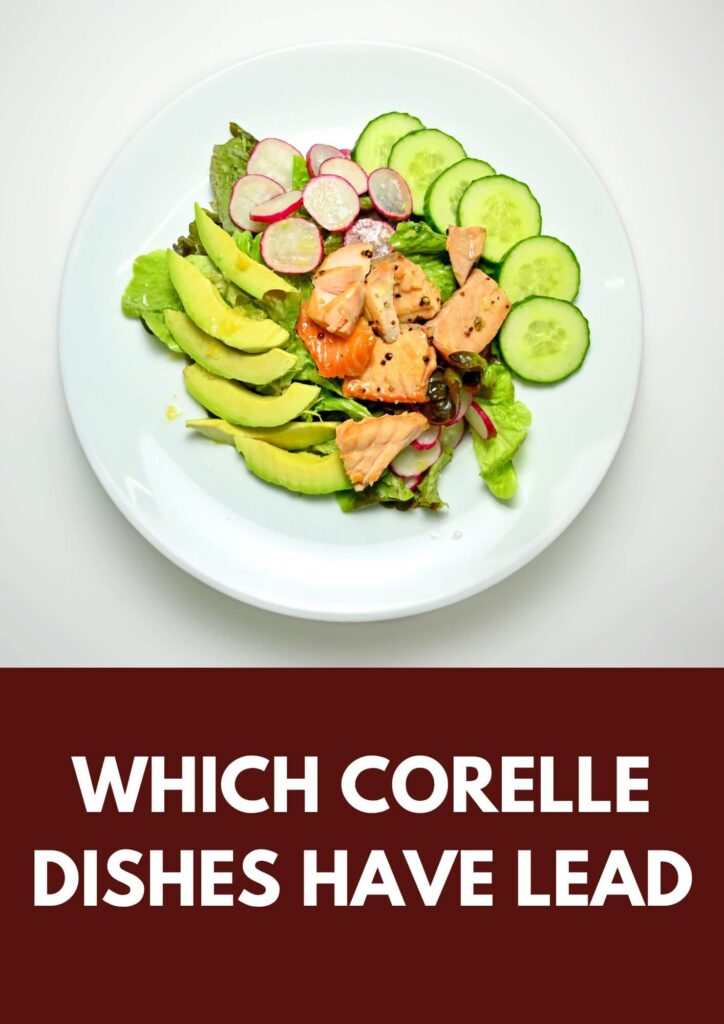
The Corelle dishes that contain lead and cadmium are some of the old Corelle patterns made before 2000, such as the Corelle butterfly gold, because they were made with lead-based paints, the manufacturing process exposed to lead, and Corelle has advised to use them as decorative pieces.
PICTURES OF CORELLE DISHES THAT HAVE LEAD
Now, let’s see the pictures of Corelle dishes that contain Lead.
Let’s recall that If Corelle dishes have lead, it’s likely due to old manufacturing processes. Lead was once commonly used in glazes, but modern standards prohibit its use.
However, if you have older Corelle dishes, especially those made before the late 1990s, they might contain lead.
Some examples are Vintage Corelle Meadow dish, Vintage Corelle Butterfly gold plate glass dish, Vintage Corelle Plate or crazy daisy spring Blossom Green, Vintage Corelle by corning Butterfly gold pattern glass Bowls, Vintage Corelle dish with yellow basket and blue and red flowers, Vintage cream Corelle plates with peach tulip buds. E.t.c
It’s essential to check with the manufacturer or conduct a lead test to know the amount of lead content so you stay safe and healthy.
Below are some pictures of Corelle dishes that have lead, cadmium, and even arsenic due to the extensive lead test carried out:
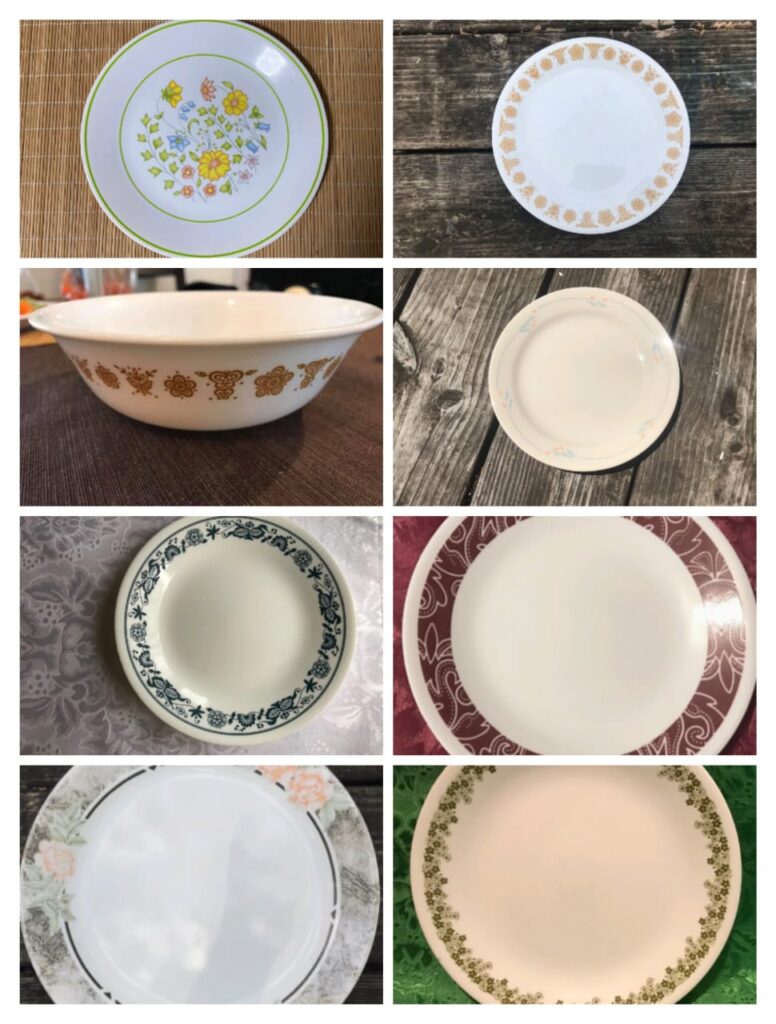
WHICH CORELLE DISHES ARE LEAD AND CADMIUM-FREE?
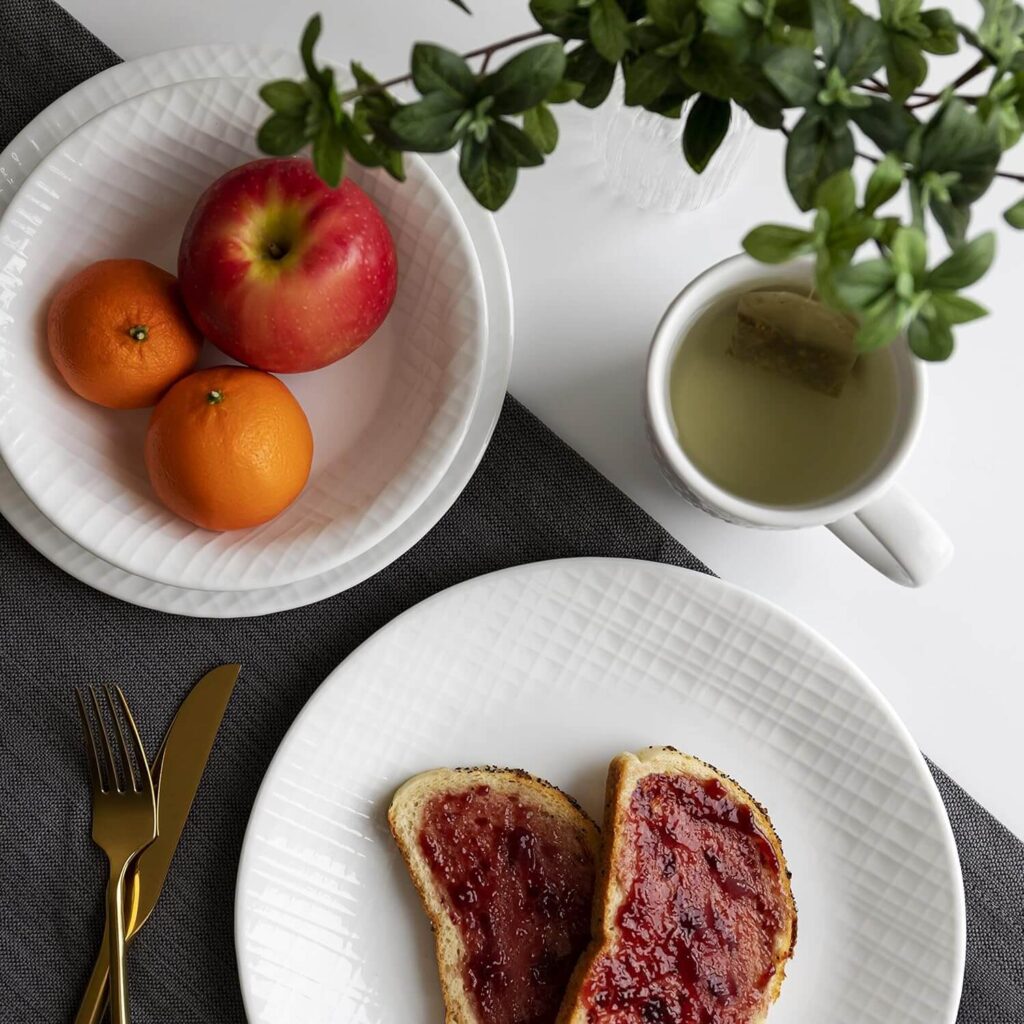
Now that we know which Corelle dishes contain lead or cadmium, we can confidently state that the lead and cadmium-free Corelle dishes are the new Corelle dishes manufactured from mid-2000, as well as the old winter frost white Corelle pattern made in 1970, even though it was one of the first and most popular Corelle patterns produced.
More examples of Corelle dishes that are lead and cadmium-free are:
Corelle white winter frost Dinnerware
Corelle white winter frost Livingware Dinnerware set
Corelle Vitrelle Winter frost white Plates and Bowls
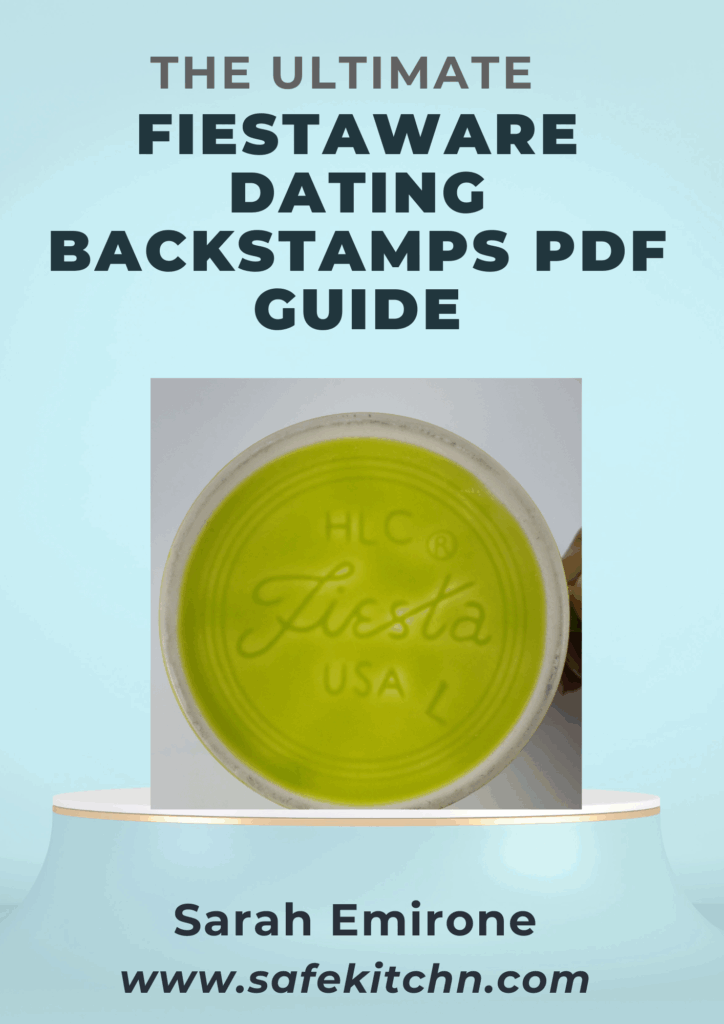
ARE WHITE CORELLE DISHES LEAD-FREE?
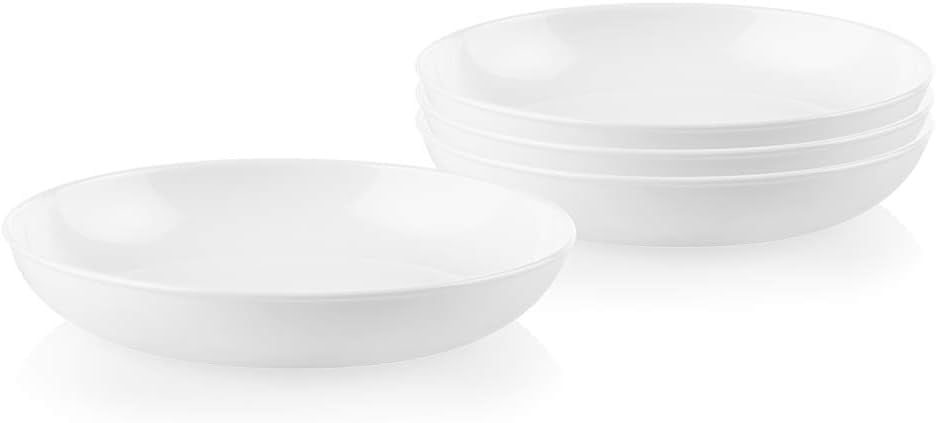
Absolutely yes, all the pure white Corelle dishes without any patterns or designs are completely lead and cadmium-free, the most common being the winter frost white Corelle pattern.
RELATED: IS CORELLE LIVINGWARE CORNING LEAD-FREE?
IS CORELLE VITRELLE LEAD FREE?
Sometimes, people confuse Corelle and Vitrelle, but they are not the same.
Vitrelle is the material used in manufacturing Corelle and this material is free from any impurities including Lead so we can say that Corelle Vitrelle is free from lead and cadmium.
DO ALL CORELLE DISHES CONTAIN LEAD?
It is NOT all Corelle dishes that contain Lead; rather it is some of the old Corelle dishes made predominantly with patterns, decoration, or glaze that contain Lead and when damaged could leach lead or cadmium into your meals.
Therefore, are new corelle dishes Lead free? Yes, the New Corelle patterns or product lines made after 2000/2005 and all pure white Corelle dishes, either old or new, are 100% lead-free.
CORELLE PLATES LEAD
It is common knowledge what Corelle plates are made of – Vitrelle glass; a tempered glass material known for its durability and lightweight nature.
They are popular for everyday use due to their resistance to breaking, chipping, and scratching.
As for lead content, Corelle plates have been a subject of concern in the past due to the use of lead in some of their decorations and patterns, particularly those produced before the late 2000s.
Lead is a toxic substance that can leach into food and pose health risks, especially when exposed to acidic foods or beverages.
Recent studies have shown that while lead was historically used in the decorations of some Corelle patterns, the company has since transitioned to lead-free materials in response to consumer safety concerns and regulatory requirements.
However, it’s essential to note that older Corelle plates or those purchased from secondhand sources may still contain lead in their designs.
The Consumer Product Safety Commission (CPSC) sets regulations regarding lead content in consumer products, including tableware.
These regulations restrict lead content to very low levels in products intended for food use.
To ensure safety, consumers are advised to check the packaging or contact the manufacturer to confirm that the Corelle plates they are purchasing meet current safety standards and do not contain lead in any part of their design or construction.
In summary, while lead was previously used in some Corelle plate decorations, recent studies indicate that newer Corelle plates are lead-free and comply with safety regulations.
Safekitchn
However, consumers should exercise caution with older plates or use them for decorative purposes and verify the lead content with the manufacturer when in doubt.
HOW DO I KNOW IF MY CORELLE DISHES ARE SAFE?
The new Corelle dishes are usually regarded as safe for regular use since they comply with FDA rules and use an innovative manufacturing technique that eliminates the use of lead and cadmium.
However, it is recommended you check for any visible damage like chips or cracks, as these can compromise the safety of the dishes.
Additionally, ensure that they are not made with any materials that you may be allergic to or sensitive to.
In addition, is it safe to use old Corelle dishes? No, it is not safe as Corelle has advised its users to use their old Corelle patterns as decorative pieces as their old dinnerware was made with lead glazes.
Finally, if you still have specific concerns, you can also reach out to Corelle’s customer service for more information.
CORELLE PATTERNS AFTER 2005
Corelle introduced several new patterns after 2005, including popular designs like “City Block,” “Kyoto Leaves,” and “Shadow Iris.”
These patterns often feature contemporary or nature-inspired motifs and are known for their durability and chip resistance.
Corelle’s post-2005 patterns are all lead and cadmium-free and continue the brand’s tradition of practical yet stylish dinnerware options.
CORELLE POISONING FROM CORELLE DISHES
Corelle plates are known for their durability and resistance to chipping, but there have been concerns about the potential for lead poisoning due to the presence of lead in the paint or glaze used on some older Corelle dishes.
Lead is a toxic substance that can leach into food or drinks stored or served on these plates, especially if they are scratched, chipped, or damaged in any way.
Consumer Reports Investigation (2018): Consumer Reports conducted an investigation into lead and cadmium in popular brands of dinnerware.
They found that some older Corelle patterns contained lead and cadmium levels above the limits set by the Food and Drug Administration (FDA).
University of Plymouth Study (2020): A study published by the University of Plymouth in the UK tested a variety of tableware products.
They found that some samples contained lead and cadmium, raising concerns about potential health risks, particularly for children.
According to the Centers for Disease Control and Prevention (CDC), there is no safe level of lead exposure, especially for children.
Lead poisoning can lead to serious health problems, including developmental delays, learning difficulties, and behavioral issues.
Children are particularly vulnerable to lead poisoning because their bodies absorb lead more easily than adults’ bodies.
The risk of lead exposure from Corelle plates depends on factors such as the age of the plates, the specific pattern, and whether they have been damaged or scratched.
To reduce the risk of lead exposure, consumers are advised to:
Avoid using older Corelle plates, especially those manufactured before the company’s switch to lead-free glazes in the mid-2000s.
Inspect plates for any signs of damage, such as chips or scratches, and refrain from using them if found.
Consider purchasing newer Corelle products labeled as lead-free or made with lead-free glazes.
While the FDA has regulations in place to limit the amount of lead and other harmful substances in tableware, enforcement and monitoring of these standards can vary, leading to potential gaps in consumer protection.
Lead poisoning can have serious health consequences, especially for children and pregnant women.
Consumers need to be aware of the potential risks associated with older Corelle plates and take appropriate precautions to minimize exposure.
While Corelle plates are generally considered safe for use, there have been concerns about lead exposure from older models.
Consumers should be vigilant, inspect their dinnerware for any signs of damage, and consider replacing older Corelle plates with newer ones or disposing of their Corelle dishes correctly and then go for lead-free alternatives to minimize the risk of lead poisoning.
HOW DO YOU KNOW IF DISHES HAVE LEAD IN THEM?
There are several ways to determine if the dinnerware you use contains lead; the first step is to look for the manufacturer’s label, as most lead-free plates now come with labels.
Second, if your plate has antique or historic patterns, keep in mind that the glaze may include lead or cadmium, which could leach into your food through fractures or chips.
Consult a lead specialist to do a lead test on your tableware using an XRF instrument to measure the quantity of lead, or consider using one of the inexpensive lead testing kits available for detecting the presence of lead in ceramics.
For example, there have been debates about whether there is lead in Corelle Snopes dishes; the easiest way to find out is to perform a lead test on your lead Snopes dish; if the patterns or glaze contain lead, it will reflect.
2 thoughts on “Pictures of Corelle Dishes that have Lead”
Comments are closed.